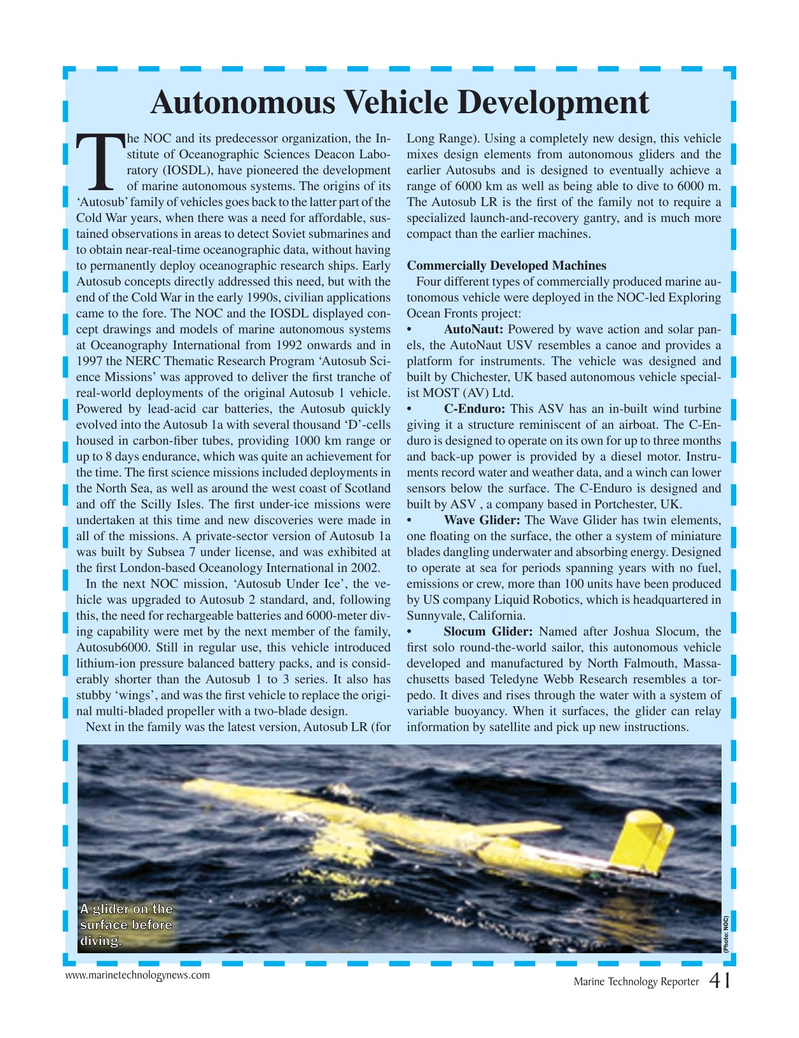
Page 41: of Marine Technology Magazine (January 2016)
Underwater Vehicle Annual: ROV, AUV, and UUVs
Read this page in Pdf, Flash or Html5 edition of January 2016 Marine Technology Magazine
Autonomous Vehicle Development he NOC and its predecessor organization, the In- Long Range). Using a completely new design, this vehicle stitute of Oceanographic Sciences Deacon Labo- mixes design elements from autonomous gliders and the ratory (IOSDL), have pioneered the development earlier Autosubs and is designed to eventually achieve a
Tof marine autonomous systems. The origins of its range of 6000 km as well as being able to dive to 6000 m. ‘Autosub’ family of vehicles goes back to the latter part of the The Autosub LR is the ? rst of the family not to require a
Cold War years, when there was a need for affordable, sus- specialized launch-and-recovery gantry, and is much more tained observations in areas to detect Soviet submarines and compact than the earlier machines. to obtain near-real-time oceanographic data, without having to permanently deploy oceanographic research ships. Early Commercially Developed Machines
Autosub concepts directly addressed this need, but with the Four different types of commercially produced marine au- end of the Cold War in the early 1990s, civilian applications tonomous vehicle were deployed in the NOC-led Exploring came to the fore. The NOC and the IOSDL displayed con- Ocean Fronts project: cept drawings and models of marine autonomous systems • AutoNaut: Powered by wave action and solar pan- at Oceanography International from 1992 onwards and in els, the AutoNaut USV resembles a canoe and provides a 1997 the NERC Thematic Research Program ‘Autosub Sci- platform for instruments. The vehicle was designed and ence Missions’ was approved to deliver the ? rst tranche of built by Chichester, UK based autonomous vehicle special- real-world deployments of the original Autosub 1 vehicle. ist MOST (AV) Ltd.
Powered by lead-acid car batteries, the Autosub quickly • C-Enduro: This ASV has an in-built wind turbine evolved into the Autosub 1a with several thousand ‘D’-cells giving it a structure reminiscent of an airboat. The C-En- housed in carbon-? ber tubes, providing 1000 km range or duro is designed to operate on its own for up to three months up to 8 days endurance, which was quite an achievement for and back-up power is provided by a diesel motor. Instru- the time. The ? rst science missions included deployments in ments record water and weather data, and a winch can lower the North Sea, as well as around the west coast of Scotland sensors below the surface. The C-Enduro is designed and and off the Scilly Isles. The ? rst under-ice missions were built by ASV , a company based in Portchester, UK.
undertaken at this time and new discoveries were made in • Wave Glider: The Wave Glider has twin elements, all of the missions. A private-sector version of Autosub 1a one ? oating on the surface, the other a system of miniature was built by Subsea 7 under license, and was exhibited at blades dangling underwater and absorbing energy. Designed the ? rst London-based Oceanology International in 2002. to operate at sea for periods spanning years with no fuel,
In the next NOC mission, ‘Autosub Under Ice’, the ve- emissions or crew, more than 100 units have been produced hicle was upgraded to Autosub 2 standard, and, following by US company Liquid Robotics, which is headquartered in this, the need for rechargeable batteries and 6000-meter div- Sunnyvale, California.
ing capability were met by the next member of the family, • Slocum Glider: Named after Joshua Slocum, the
Autosub6000. Still in regular use, this vehicle introduced ? rst solo round-the-world sailor, this autonomous vehicle lithium-ion pressure balanced battery packs, and is consid- developed and manufactured by North Falmouth, Massa- erably shorter than the Autosub 1 to 3 series. It also has chusetts based Teledyne Webb Research resembles a tor- stubby ‘wings’, and was the ? rst vehicle to replace the origi- pedo. It dives and rises through the water with a system of nal multi-bladed propeller with a two-blade design. variable buoyancy. When it surfaces, the glider can relay
Next in the family was the latest version, Autosub LR (for information by satellite and pick up new instructions.
A glider on the surface before diving.
(Photo: NOC) www.marinetechnologynews.com
Marine Technology Reporter 41
MTR #1 (34-49).indd 41 1/26/2016 1:28:35 PM

 40
40

 42
42
